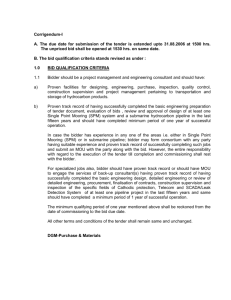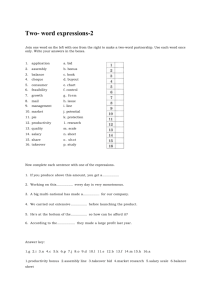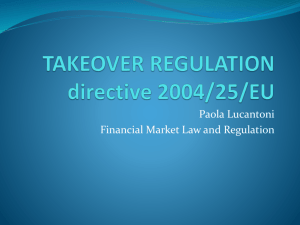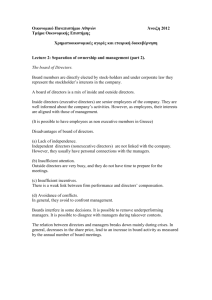Hostile Takeovers
advertisement
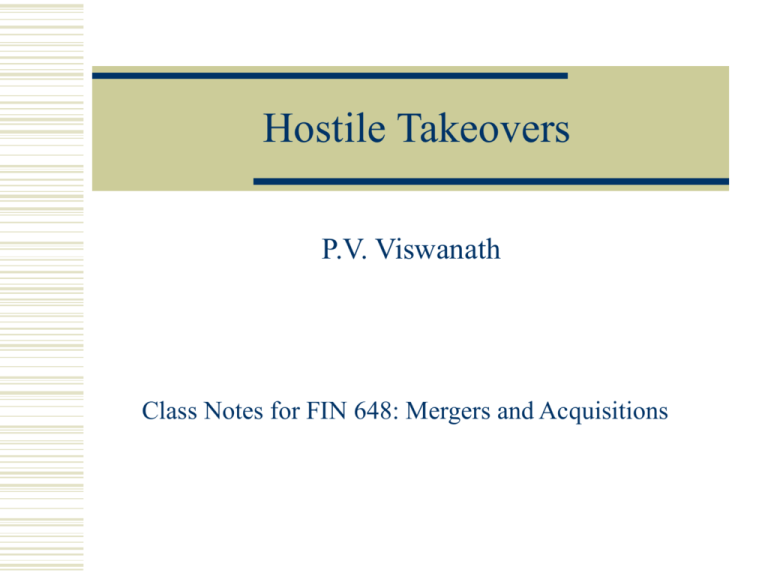
Hostile Takeovers P.V. Viswanath Class Notes for FIN 648: Mergers and Acquisitions Framework A hostile tender offer begins with an unsolicited offer by a bidder to purchase a majority or all of the target firm’s shares. The bidder will set the offer for a particular period of time, at a price, and with a form of payment, and may attach conditions to the offer. The target will ordinarily undertake evasive maneuvers. How to analyze a takeover scenario: Gain the perspective of the various players in the takeover scenario. Master important rules and defenses that constrain the players Anticipate the paths that outcomes may take. P.V. Viswanath 2 Profile of the target of a hostile bid Inefficiency Hypothesis: Targets of hostile bids show lower sales growth, returns on equity, and price/earnings ratios. They have lower insider ownership and suffer disproportionately from entrenched management and inefficient use of corporate assets. They show higher liquidity and unused debt capacity. Some studies show higher management turnover for hostile takeover targets. P.V. Viswanath 3 Hostile Bid Targets: an alternative profile Investment Opportunities Hypothesis: Targets present attractive investment opportunities owing to strong growth prospects or synergies. There is little evidence of poor performance prior to bids. Reconciliation: Not basket cases, but not stellar performers. Mediocre performance in which the bidder sees a profitable opportunity for takeover. Entrenchment of target management is key: bidders resort to forceful entry when target managers reject friendly offers. P.V. Viswanath 4 Profile of Hostile Takeovers Takeover attempts from 1975 to 2000. The odds are not good for the bidder, but the target is unlikely to remain independent. Total M&A done deals Total confirmed, unsolicited Of those that were unsolicited: Friendly Neutral Hostile Of those that were hostile: Target sold to hostile bidder Target sold to another bidder4 Successful defense, target not sold P.V. Viswanath 93,312 1.20% 9.70% 58.10% 32.20% 371 24.50% 30.70% 44.80% 5 After the bid Bidders win significantly positive abnormal returns over the medium term. Target shareholders win as well, receiving higher acquisition premiums in hostile deals. When a target successfully rejects a bidder, the target’s share price falls but to a price level higher than prevailed ex ante. The takeover attempt stimulates a restructuring that unlocks value for shareholders. When the bidder offere cash, the returns are more positive still. P.V. Viswanath 6 Players in the game Bidder: entrepreneurs who discover profitable opportunities. Target: the profitable opportunity Free riders: other shareholders who profit by the actions of the bidder. Groups within the target Managers vs. directors Insiders vs. outside directors Large shareholders vs. small shareholders Other potential buyers: white knights and white squires Arbitrageurs P.V. Viswanath 7 Estimating Return to the Arb The target receives a bid at $60, when its shares are trading at $40. The price leaps to $57. The bidder’s share price declines $3 (from $53) upon the announcement to close at $50. This price is assumed to drop further by $1. Assumptions Position and Payoff in Target Shares Buy Target shares at Value of Target Shares at End of Holding Period Gross Spread Per Share on Target shares Position and Payoff in Buyer Shares Short Buyer shares at Value of Buyer Shares at End of Holding Period Gross Spread Per Share on Buyer shares Total Assets of the Arbitrage Position P.V. Viswanath Days in Holding Period 40 20 $ $ $ 57.00 $ 60.00 $ 3.00 $ 57.00 60.00 3.00 $ $ $ 50.00 $ 49.00 $ 1.00 $ 50.00 49.00 1.00 $ 57.00 $ 57.00 8 Estimating Return to the Arb Short Position in Buyer Shares Borrowed shares of Buyer Debt @ % Assets Capital Employed Total Liabilities and Capital of the Arbitrage Position Net Spread Calculation Gross Spread -Interest @ - Short Dividends Foregone + Long Dividends Received Net spread Results Return on capital for holding period only Return on capital annualized P.V. Viswanath $ $ 70% $ $ $ 50.00 (50.00) 39.90 17.10 57.00 $ $ $ $ $ 50.00 (50.00) 39.90 17.10 57.00 $ 10% $ 4.00 $ (0.44) $ ($0.20) $0.30 3.66 $ 4.00 (0.22) ($0.20) $0.30 3.88 $ 21% 195% 23% 414% 9 Arbitrage Spreads Price offered by bidder minus market price of target Negative spreads imply that arbs expect a higher offer to be forthcoming soon. Positive arbitrage spreads indicate that arbs think offer is unlikely to be topped. A very large spread might mean that the arbs doubt that the offer will be consummated at all. P.V. Viswanath 10 Analyzing the Arbitrage Spread Pcurrent (Prob x Pbid ) [(1 - Prob) x Pstand-alone ] Pstand-alone can be estimated as the pre-bid price of the target Examples: Four Pending Deals on July 18, 2003 Target's Price Target Bidder Current Bid Price Pre-Bid* Probability of Closing PeopleSoft Oracle $ 17.82 $ 19.50 $ 15.00 63% Dana ArvinMeritor $ 15.54 $ 14.99 $ 11.50 Expect Higher Bid Clayton Homes Berkshire Hathaway $ 13.01 $ 12.50 $ 11.00 Expect Higher Bid Handspring Palm $ 0.99 $ 1.45 $ 0.85 24% * Using the pre-bid price in this calculation assumes that it is a fair estimate of the target's value per share if the deal does not close. P.V. Viswanath 11 Two-tier tender offers In 1988 Robert Campeau made a tender offer for Federated Department Stores. Here is a simplified version. Suppose that the pre-takeover price of a Fed share is $100. Campeau offers to pay $105 per share for the first 50% of the shares, and $90 for the rest. All shares, however, are bought at the average price of the total shares tendered. If the takeover succeeds, the shares that were not rendered are worth $90 each. If not, all shares are returned. e.g. if 75% of the shares are tendered, Campeau pays $105 to the first 50% and pays $90 to the remaining 25%. The average price that Campeau pays is then equal to P = 105 x (50/75) + 90 x (25/75) = 100 P.V. Viswanath 12 Two-tier tender offers In general, if s percent of the shares are tendered the average price paid by Campeau, and thus the price of a tendered share, is given by P = 105 if s < 50 and P = 105x(50/s) + 90x(s-50/s) if s > 50 If everybody tenders, i.e., s =100, then Campeau pays $97.5 per share which is less than the current market price. So, this looks like a good deal for Campeau, but only if sufficiently high number of shareholders tender. The question is – will target shareholders tender? P.V. Viswanath 13 Reaction of target shareholders The options for A & B, the two shareholders, are “Tender” or “Hold Off.” We assume that one share (out of two) is enough for the raider to gain control. The first entry is A’s payoff and the second is B’s. A Tender Hold Off B Tender Hold Off 97.5, 97.5 105, 90 90, 105 100, 100 A’s optimal strategy is to tender independent of what B does. If B tenders, then A gets 97.5; if B doesn’t tender, he gets 105, compared to payoffs of 90 and 100 for holding off. Since the same holds for B, they will both tender. P.V. Viswanath 14 White Knights So it looks like a great deal for Campeau. But there is an incentive for a spoiler. Suppose Macy comes in and offers $102. We assume that both shares are needed for a takeover. Now the deal looks more like this. A Tender Hold Off B Tender Hold Off 97.5, 97.5 102, 102 102, 102 102, 102 Now the optimal strategy is no longer to tender to Campeau. In fact, Macy offered substantially more and Campeau had to bump up his offer. He ultimately won, but he paid about 2.5 times the pre-acquisition price of Federated. He had to take on so much debt that he ultimately went bankrupt. P.V. Viswanath 15 Two-tier tender offers Coercive two-tier tender offers are not legal any more. However, it’s possible to structure incentives so that early tenders get a large and more certain payment. Later tenderers could be implicitly threatened by a future “minority shareholder freeze-out.” Still, arbs have to assess the reaction of other shareholders. P.V. Viswanath 16 Value of not tendering The arb will tender unless the expected value of not tendering (EVNT) is greater than the dollar value of the tender offer. EVNT = [Sno-competing-bid.Pr]+[Scompeting-bid.(1-Pr)] Hence the raider must offer a price > EVNT. Sno-competing-bid can be based on an assumption that the target will not restructure or that it will try to unlock value. The bidder can do a sensitivity analysis and consider the reasonableness of the various alternatives to decide how to bid. The bidder can pre-emptively bid high (bear hug) or bid low, which might lead to a longer contest. P.V. Viswanath 17 Takeover Defenses Decrease the perception of intrinsic value of target to attacker. Spin-offs, special dividends, asset sales, options to sell “crown jewels,” threats of union opposition or of customer defections. Synergies and other benefits may only become available following a takeover of operations, restructuring and integration with buyer. Delay benefits of takeover by using staggered boards, supermajority provisions, waiting periods, presenting arguments to antitrust regulators (if target and attacker in same industry) P.V. Viswanath 18 Takeover Defenses Increase the price paid by attacker. Golden Parachutes Poison Puts Topping or breakup agreements Target management may have knowledge of hidden values not know to the market, such as dormant land carried at cost rather than market value on the books. Disclosure of such hidden values might help persuade shareholders to hold out for a higher price. Poison Pills Increase transactions costs of attacker by defensive litigation and defensive appeals to regulators. P.V. Viswanath 19
